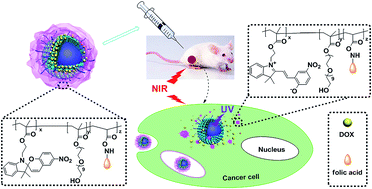Near-infrared light-controlled drug release and cancer therapy with polymer-caged upconversion nanoparticles†
Abstract
Herein, a core–shell nanocomposite was fabricated by self-assembly of the photo-responsive copolymer with silica-coated upconversion nanoparticles for near-infrared light-controlled drug release and cancer therapy. Firstly, lanthanide upconversion nanoparticles (UCNPs) co-doped with Yb3+ and Tm3+ were encapsulated with mesoporous silica as the core (MUCNPs). Then a folate conjugated light-responsive copolymer (PSMN-FA) was synthesized and coated on MUCNP as the shell via self-assembly. Anti-cancer drugs could be loaded into the mesopores of the silica layer before polymer coating. Upon near-infrared (NIR) light irradiation at 980 nm, the caged UCNPs emitted luminescence in the UV region, which could change the structure of the amphiphilic copolymer and separate it from the MUCNPs, immediately followed by the release of the pre-loaded drugs to the targeted cancer cells. Our model experiments in vitro verified that the nanocarrier MUCNPs@C18@PSMN-FAcan provide active tumor targeting to folate receptor over-expressed (FR+) tumor cells. Both in vitro and in vivo studies were carried out to evaluate the NIR-controlled drug release strategy and the promising application in anticancer therapy based on the polymer-UCNPs nanocomposites.


 Please wait while we load your content...
Please wait while we load your content...